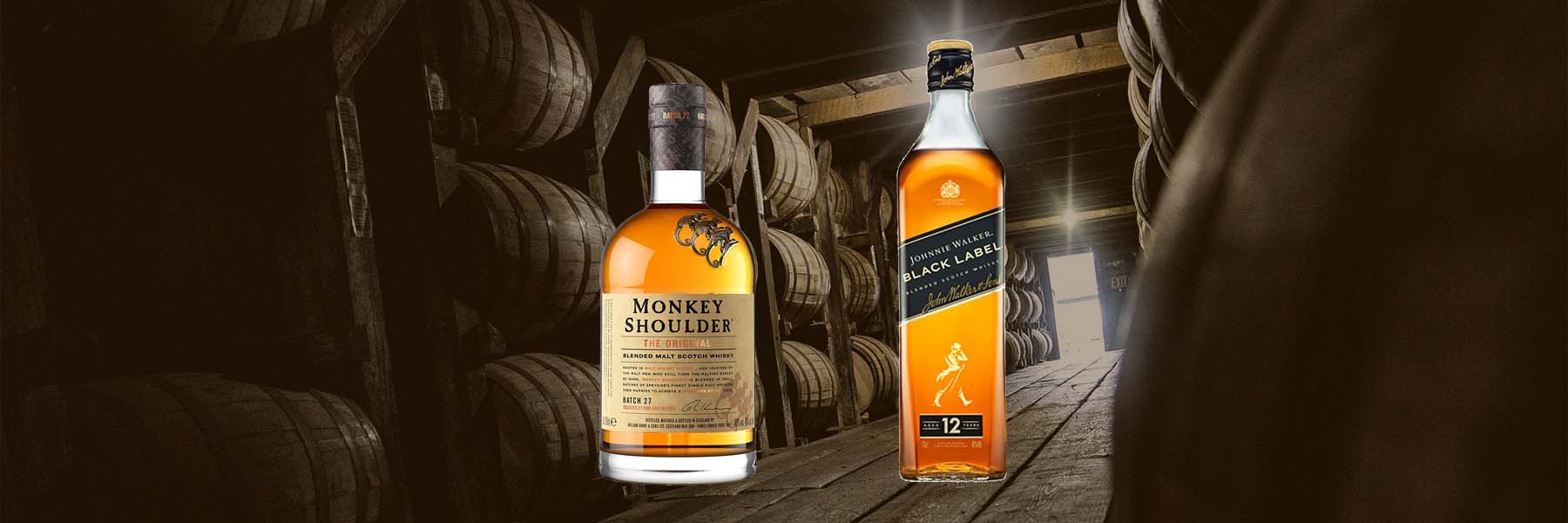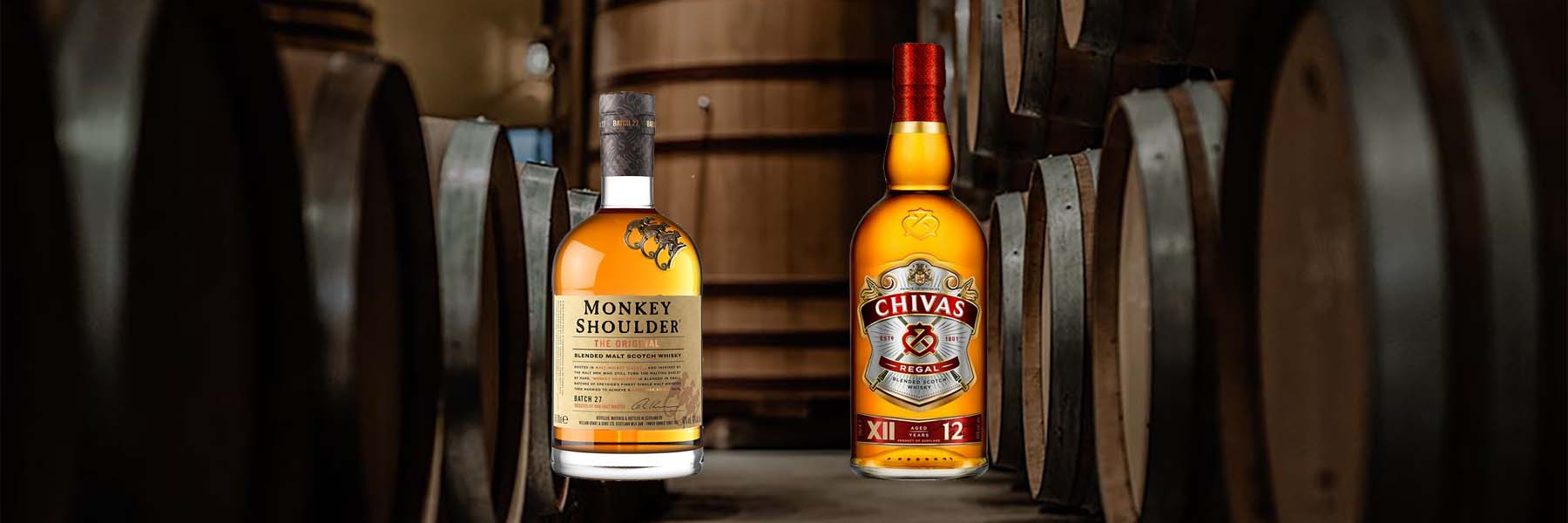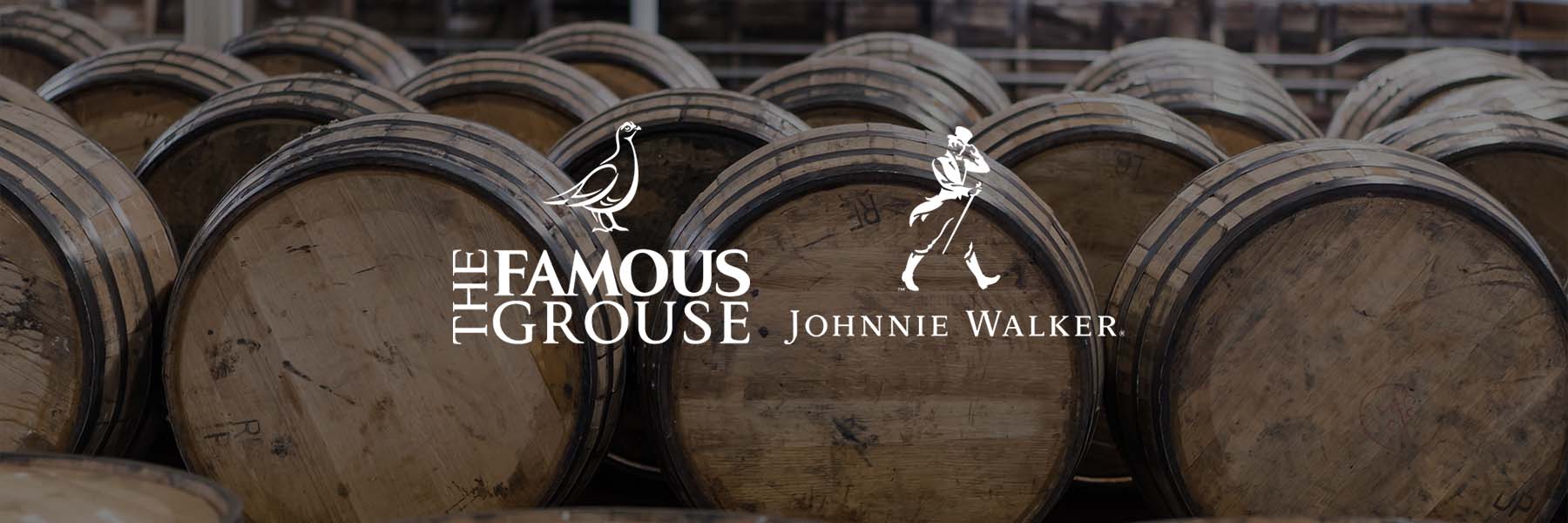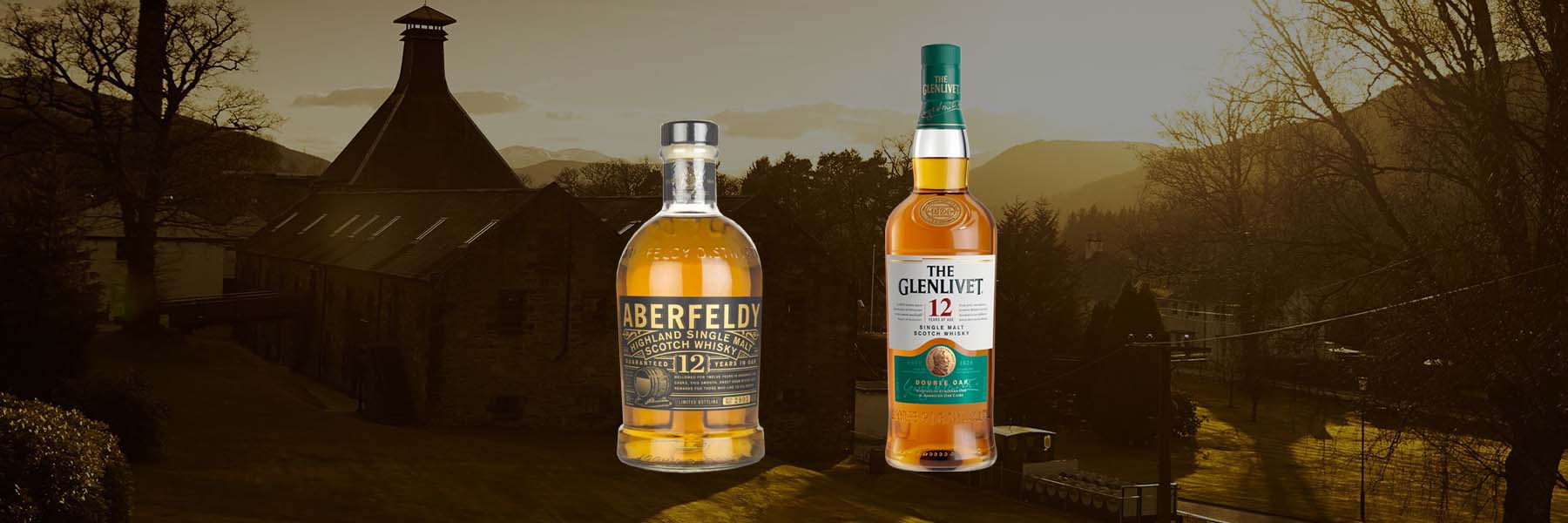Glenlivet 18 vs Glenfiddich 18 | Which one is best?
Last updated on August 13th, 2024
The whisky world has two of its most beloved bottles when it comes to 18-year-old single-malt Scotch whisky: The Glenlivet 18 and the Glenfiddich 18. Both of these have achieved great reputations and accolades, and many whisky drinkers consider them to be among some of the best in the world.
Both distilleries have been in operation since the early 19th century and have a long history of producing high-quality Scotch whisky. Whilst they share similarities, there’re also some key differences between Glenlivet 18 vs Glenfiddich 18 which we’ll explore in this insightful comparison. Hopefully, this article will help guide your choice for your next whisky purchase.
Let’s dive in.
Glenlivet 18 vs Glenfiddich 18
- Both are both Speyside single malt whiskies.
- Glenlivet 18 was launched in 2015
- Glenfiddich 18 was launched in 1986
- Glenlivet is fermented for 50 hours
- Glenfiddich is fermented slightly longer, ranging between 48-72 hours
- Both whiskies use traditional double pot still distillation
- Glenlivet is matured in a combination of first-fill and second-fill American oak casks as well as ex-sherry casks
- Glenfiddich is matured for 18 years in Oloroso sherry and bourbon casks this is then married in small batches of 150 casks for final maturation

Glenlivet 18 Tasting notes
Nose: Strong and versatile. Notes of chewy sultanas, Sherry-soaked peels, barley sugars, toasty grains, apple blossom, petals, fudge, and faint wisps of smoke.
Palate: Rich and full of notes of tannic oak and chewy. A combination of Manuka honey, walnuts, Cox’s apples, and orange peels.
Finish: Dry and long with a note of spicy oak.
Glenlivet 18 Price: £84 / $102
Glenlivet 18 Review
The Glenlivet 18 year old whisky is a rich and full-bodied spirit with a well-balanced profile that combines the best of Glenlivet’s unique distillation process. On the nose, Glenlivet 18 year old whisky has strong, complex aromas of chewy sultanas, Sherry-soaked peels, barley sugars, toasty grains, and faint wisps of smokiness.
On the palate, Glenlivet 18 year old whisky’s flavour profile becomes even more nuanced and layered. Notes of tannic oak provide a pleasantly earthy base for notes of honeyed sweetness from Manuka honey and Cox’s apples. Walnuts add a subtle nutty layer while zesty orange peel brings a refreshing citrusy finish. Glenlivet 18 year old whisky is sweet but balanced with a dry, spicy oak finish that lingers on the tongue.
Glenlivet 18 year old whisky has been aged in a combination of American ex-bourbon cask and European ex-sherry cask made from American and European oak which impart additional complexity to the whisky. A smaller amount of Glenlivet is also placed in American-made ex-Sherry casks for extra flavour before being finished in new French Limousine oak from Dordogne for its final maturation stage. This careful aging process ensures that Glenlivet 18 year old whisky has achieved its perfect balance after spending at least 18 years in oak barrels before it is bottled and shipped to its final destination.
At £84 / $102 per bottle Glenlivet 18 year old whisky is an excellent value for money as it provides a complex yet smooth drinking experience with each sip. The Scotch enthusiast can be sure that Glenlivet 18 will provide an unforgettable experience with its intense aromas and layered flavours that are packed into each bottle.
Many different foods pair well with the Glenlivet. It blends well with salmon, smoked fish, and pork thanks to its light flavour and gentle complexity.
For desserts or starters, cheeses like cheddar, brie, or bleu are good options. Gourmet coffee, bread puddings, apple pie, and crumble all fit the sweet profile. Or if you’re more of a cocktail instead of a dessert person trying the Glenlivet 18 in an Old Fashioned may be the best treat of all. Check out this mesmerising cocktail making video from Glenlivet’s YouTube channel.

Tasting notes at a glance: Glenfiddich 18
Nose: Lots of fruit, baked toffee apples, grapefruit, dry, chocolate flake-y wood and cinnamon.
Palate: Candied fruits and Glenfiddich freshness with a balance of dried apricot, cinnamon, toffee, ginger, and dry Sherry.
Finish: Peels with a touch of salted coffee.
Price: £76 / $93
Glenfiddich 18 Review
Glenfiddich 18 is a single malt Scotch whisky from the Glenfiddich Distillery, located in Dufftown, Scotland. It has a rich and intense nose of sherry, raisins and vanilla with a hint of butterscotch, as well as a sweet malty taste including honey, chocolate and spice. The finish is long-lasting and smooth, with oak notes providing an undercurrent to the other flavours.
Glenfiddich 18 was aged for eighteen years in vintage oak casks from Jerez de la Frontera in Spain. In addition to the sherry and mellow wood flavours that come from these casks, Glenfiddich 18 offers subtle hints of dried fruits like apricot and figs for added complexity and depth. On the palate, Glenfiddich 18 has a soft mouthfeel with floral notes, biscuit rye flavours as well as dried fruit such as figs, prunes and dates.
The spicy finish lingers on the palate for some time leaving behind flavours of cinnamon and nutmeg. Glenfiddich 18 is a very versatile whisky that can be enjoyed neat or on the rocks or used in cocktails to create classic drinks like old-fashioned or Manhattans.
Similar to the Glenlivet, Glenfiddich’s light and delicate flavours make for a seamless pairing.
Try fatty meats like steak, lamb, or pork for an entrée. Salmon and tuna are also good choices, but you should try sushi, sashimi, or even duck for a more unique experience. Even a tasty cheese like goat cheese or brie to round out your meal. Fresh fruit, baked pears, toffee pudding, strawberries and cream, or any other sweet to complement the whisky can be served for dessert.
Comparing Glenlivet 18 vs Glenfiddich 18
| Glenlivet 18 vs Glenfiddich 18 | Glenlivet 18 | Glenfiddich 18 |
| Colour | Old gold, apricot | Dark gold |
| Nose | Rich fruit, toffee | Rich aroma with ripe orchard fruit, robust oak and baked apple |
| Palate | Balanced, bursts of sweet orange | Glenfiddich freshness with a balance of dried apricot |
| Finish | Long, with a raisins and spice | Peels with a touch of salted coffee |
| Rating | 8.7/10 | 7.8/10 |
| Age | 18 | 10 |
| Region | Speyside | Speyside |
| ABV | 40% | 40% |
| Classification | Single malt | Single malt |
| Cask | American and European | European |
| Chill Filtered | Yes | Yes |
| Price | $102/£84 | $93/£76 |
Final thoughts: Glenlivet 18 vs Glenfiddich 18
Celebrated by whisky connoisseurs, The Glenlivet 18 and the Glenfiddich 18 are two of the most luxurious Scotch whiskies. These Speyside single malt distilleries each offer a unique taste profile that will surely captivate your palate.
The Glenlivet 18 offers a complex flavour, with subtle touches of sherry blended in and a silky finish. On the other hand, the Glenfiddich 18 presents itself as more robust – blending together delectable flavours that range from toffee and fruit to vanilla and oak.
If you’re searching for a whisky to make your special occasion extra memorable or just want something to cosy-up with on a quiet night in, either of these two whiskies will do the trick. Both Glenlivet 18 and Glenfiddich 18 are extraordinary, so if you can’t decide between them- rest assured that each provide an excellent drinking experience worthy of any Scotch aficionado.
Related posts
If you’re keen to learn more about the differences between these two popular Speyside distilleries, why not check out our other comparisons?

If there’s one thing Speyside is famous for, it’s whisky. The region is home to some of the most renowned Scotch whisky distilleries in the world, producing a large variety of single malt and blended whiskies. Many of the whiskies produced in Speyside are considered to be some of the finest in the world; including The Glenlivet and Glenfiddich. Their distilleries are located 30km from each other.
About Glenlivet
If you’re new to whisky, especially Scotch, you’ll notice the frequent use of the word ‘glen’. Well, glen equates to a ‘narrow valley’ – which there happens to many in the rugged landscape of Scotland.
Based in Ballindalloch in Moray is the parish of Glenlivet, home to the river Livet in Speyside. Back in the days of illicit distilling (pre 1832) this remote region hosted numerous whisky-making operations, many of which made their own illegal kind of Glenlivet whisky.
The Duke of Gordon, landlord to the Glenlivet and wider Speyside region, was aware of the illicit distillation being performed on his extensive land. Instead of missing tax from these ‘moonshiners’ he levied a bill titled ‘The Excise Act’ of 1823, which therefore made alcohol distillation legal.
In 1824, a local farmer called George Smith founded one of the first legally licenced Speyside distilleries in the remote area of Glenlivet. There he began producing very high-standard Scotch whisky which far exceeded that of the remaining illicit distillers.
In an attempt to coat-tail Smith’s quality whisky, and profit from his growing reputation, the illicit makers also began calling their spirits Glenlivet. Eventually in 1884, these sub-par replications led Smith to take these imitators to court where the Glenlivet Indenture was created.
An agreement was put in place that Smith’s distillery could be the only one in Speyside with the moniker of ‘The Glenlivet’. Other distilleries were permitted to use the term in their name, as long as it was secondary or hyphenated after their name. For example, Tomintoul-Glenlivet.
Making Glenlivet 18
Sourcing their Grain
The Glenlivet source their barley from the commercial malting plant Crisp Maltings based in Portgordon, Moray. First, they steep the grain in water three times to initiate germination where rootlets develop. To halt further germination, they then kiln dry the barley using warm air. Instead of using peat, this neutral heat source allows more of the grain’s full flavour to come through in the final whisky, omitting any phenols from peat smoke.
Mashing
The malted barley is then delivered to the Glenlivet distillery in Ballindalloch, where it’s then ground into a coarse flour mixture (grist) using a motorised roller mill. The grist is then added to their modernised lauter tuns and mixed with hot water for mashing. This process extracts and converts the barley’s starches into a sugary liquid called wort. By repeatedly mashing and draining the grist, maximum sugar extraction is attained.
Fermentation
Once the sugary wort liquid is cool, it’s pumped into the distillery’s large wooden washbacks. Made from Oregon Pine, these large cylindrical vats hold the wort where yeast is then added. For two days straight, the yeast feeds on the sugars within the wort converting it into a basic 9% ABV beer called wash.
1st Distillation
The wash is then transferred to the first of two pot stills. The liquid is slowly heated from the bottom which begins to boil the beer. As alcohol has a lower boiling point than water, alcoholic vapours evaporate their way to the top of the still and out into a condenser. This cools the alcoholic vapours back into a liquid form known as low wines with an ABV of around 30%.
2nd Distillation
To further purify the low wines and achieve a higher alcohol percentage, the low wines are then transferred to the spirit still. Once more, the liquid is heated so that the stronger alcoholic vapours are condensed and collected. With a 70% ABV, this second distillation produces a much stronger alcohol called new make spirit which is then ready for maturation.
Maturation
Crystal clear, the new make spirit is matured in a combination of casks to give the 18-year-old its colour and complex flavour profile. These vessels include first-fill and second-fill American oak casks which provide tropical fruit flavours such as orange and pineapple. For spicy complexity, the new make is also matured in ex-sherry casks. After 18 years, these casks are then emptied and combined to ‘marry’ the spirit before bottling.
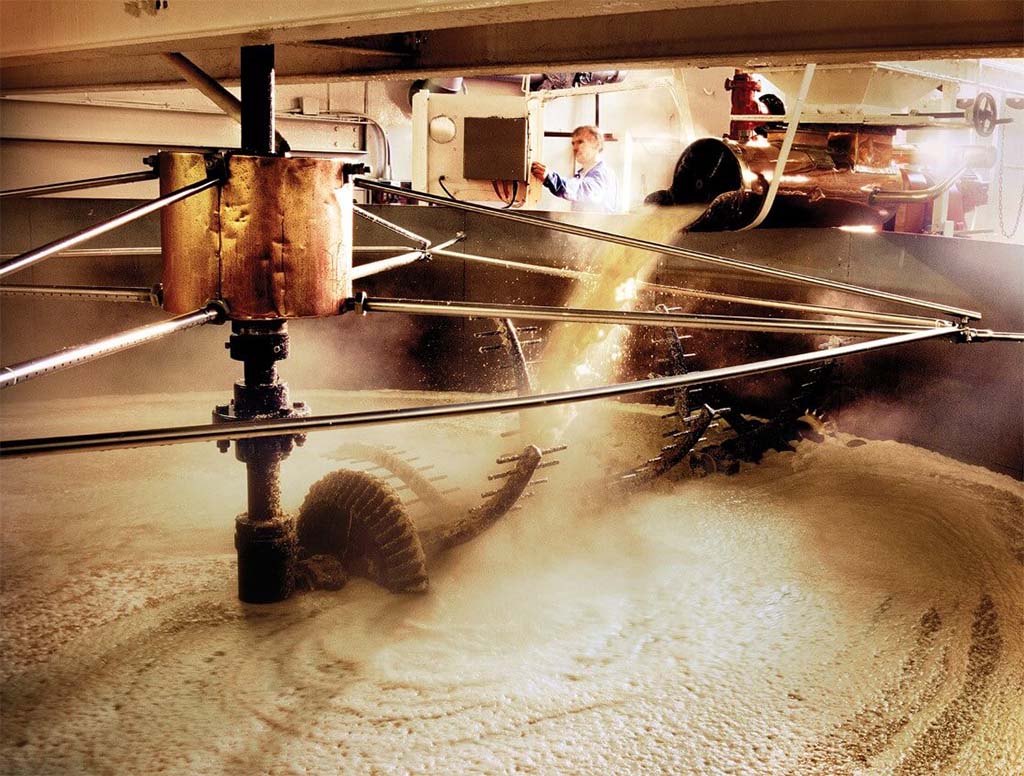
Making Glenfiddich 18
Borrowed from Balvenie
Both owned by William Grant & Sons, Glenfiddich source their grain from the traditional floor maltings at The Balvnenie distillery in Dufftown, Scotland. There, they soak the grain with multiple batches of water to fool the grain into a germination state. Scattered over the malting room floor, the grain develops small rootlets as it germinates. To prevent growing too much, Balvenie malt-men then halt the germination by drying the sprouted grain with hot air. This completes the malting process.
Mashing
Glenfiddich’s methods are very similar to those used by Glenlivet. Delivered from the Balvenie maltings, the malted barley is ground into coarse flour and then mashed with hot water to produce a sugary liquid wort. The wort is fermented with yeast for two days to convert the sugars into alcohol, making a basic form of beer. This fermentation creates fruity, floral flavours in the liquid, more commonly known as wash.
Distillation
Traditional pot stills are used to refine the wash into low wines of around 30% ABV. Using a spirit still, the low wines are re-distilled to produce the new make spirit which is ready for maturation. This crystal clear liquid has an alcohol level of about 66% ABV.
Cask ageing
To develop the flavour and colour of Glenfiddich 18, the new make spirit is matured in two cask types. From America, ex-bourbon barrels are rebuilt into hogshead casks. With their charred oak staves, they impart complex notes of dried fruit, citrus peel and sweet dates. Due to their charred interior surfaces, the new make develops its decadent dark golden colour.
Oloroso sherry casks are also used to mature the Glenfiddich 18. If you’re already a fan of sherry-finished whiskies, you’ll appreciate the spiced fruity character from these Spanish staves. During ageing, the whisky develops nutty, fruity notes and a notably reddish colour.
The bourbon and sherry casks are selected and then combined into small, carefully curated batches of 150 ‘marriage’ casks. These vessels let the two matured spirits mingle together to complete the maturation process.
Once the whisky has reached 18 years of age, it is then cut with spring water and bottled. The final product is the famous Glenfiddich 18 Scotch Whisky.
FAQs: Glenlivet 18 vs Glenfiddich 18
What makes Glenlivet 18 different from Glenfiddich 18
Glenlivet 18 is a single malt Scotch whisky aged in American oak and Spanish sherry casks. It has a smooth, full-bodied flavour with notes of dark chocolate and ripe fruit.
Glenfiddich 18 is also a single malt Scotch whisky, aged in Spanish sherry casks and American oak barrels. It has a smooth, rich taste with notes of dried fruit, brown sugar, and oak.
The main difference between Glenlivet 18 vs Glenfiddich 18 is the type of oak used in the aging process. Glenlivet 18 is aged in American oak, while Glenfiddich 18 is aged in Spanish sherry casks and American oak barrels.
What makes the Glenlivet 18 different from the Glenlivet 15?
The European oak/ex-oloroso sherry cask influence distinguishes it from the 15-Year-Old, creating a more complex and mature flavour profile.
The malt used in the 18-Year-Old is matured in a combination of European and American oak casks, creating a complexity of flavour that is not found in its younger counterpart.
The 18-Year-Old is also more robust and full-bodied than its 15-Year-Old counterpart. The flavour profile includes notes of mellow oak, sweet honey, and dried fruits. There is also a hint of spice and smoke in the background. The finish is long and smooth, with a hint of toffee and oak.
What makes the Glenfiddich 18 different from the Glenfiddich 15?
The Glenfiddich 18 is a more mature version of the Glenfiddich 15
It is a full-bodied whiskey with a velvety smooth finish. The aroma is fruity and nutty, with hints of oak and sherry. The Glenfiddich 15, on the other hand, has only been aged for 15 years and therefore has a lighter, more subtle flavour. The aromas are more floral, with notes of sweet honey and vanilla. The whiskey is lighter in body and the finish is shorter.
The Glenfiddich 15 is also aged in a combination of European and American oak casks but is predominantly matured in ex-bourbon cask and finished in Oloroso sherry casks, the 15-Year-Old has a flavour profile that is a bit lighter, less complex, and sweeter than the 18-Year-Old.



